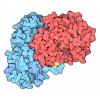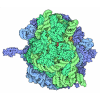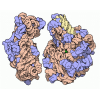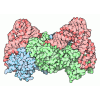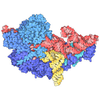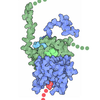+ Open data
Open data
- Basic information
Basic information
| Entry |  | |||||||||
|---|---|---|---|---|---|---|---|---|---|---|
| Title | Gcn2 dimer bound to the 60S ribosomal subunit | |||||||||
 Map data Map data | RELION PostProcess output, main map | |||||||||
 Sample Sample |
| |||||||||
 Keywords Keywords | LSU / 60S / Gcn2 / RIBOSOME | |||||||||
| Function / homology |  Function and homology information Function and homology informationcellular response to histidine / regulation of cytoplasmic translational initiation in response to stress / positive regulation of translational initiation in response to starvation / GCN2-mediated signaling / eukaryotic translation initiation factor 2alpha kinase activity / negative regulation of translational initiation in response to stress / positive regulation of cellular response to amino acid starvation / regulation of translational initiation / regulation of polysaccharide biosynthetic process / transporter complex ...cellular response to histidine / regulation of cytoplasmic translational initiation in response to stress / positive regulation of translational initiation in response to starvation / GCN2-mediated signaling / eukaryotic translation initiation factor 2alpha kinase activity / negative regulation of translational initiation in response to stress / positive regulation of cellular response to amino acid starvation / regulation of translational initiation / regulation of polysaccharide biosynthetic process / transporter complex / cleavage in ITS2 between 5.8S rRNA and LSU-rRNA of tricistronic rRNA transcript (SSU-rRNA, 5.8S rRNA, LSU-rRNA) / response to cycloheximide / protein kinase inhibitor activity / lipopolysaccharide transport / SRP-dependent cotranslational protein targeting to membrane / GTP hydrolysis and joining of the 60S ribosomal subunit / ribosomal large subunit binding / Nonsense Mediated Decay (NMD) independent of the Exon Junction Complex (EJC) / Nonsense Mediated Decay (NMD) enhanced by the Exon Junction Complex (EJC) / Formation of a pool of free 40S subunits / preribosome, large subunit precursor / L13a-mediated translational silencing of Ceruloplasmin expression / Gram-negative-bacterium-type cell outer membrane assembly / ribosomal large subunit export from nucleus / translational elongation / regulation of translational fidelity / protein-RNA complex assembly / maturation of LSU-rRNA / translational termination / translation initiation factor binding / cytosolic ribosome / cellular response to amino acid starvation / DNA damage checkpoint signaling / maturation of LSU-rRNA from tricistronic rRNA transcript (SSU-rRNA, 5.8S rRNA, LSU-rRNA) / ribosomal large subunit biogenesis / macroautophagy / translational initiation / modification-dependent protein catabolic process / protein tag activity / maintenance of translational fidelity / cell outer membrane / rRNA processing / ribosome biogenesis / double-stranded RNA binding / large ribosomal subunit / ribosome binding / protein autophosphorylation / small ribosomal subunit / 5S rRNA binding / ribosomal large subunit assembly / large ribosomal subunit rRNA binding / cytosolic large ribosomal subunit / cytoplasmic translation / tRNA binding / protein phosphorylation / non-specific serine/threonine protein kinase / protein ubiquitination / protein kinase activity / negative regulation of translation / rRNA binding / intracellular signal transduction / structural constituent of ribosome / ribosome / translation / response to antibiotic / protein serine kinase activity / mRNA binding / ubiquitin protein ligase binding / nucleolus / protein homodimerization activity / RNA binding / zinc ion binding / ATP binding / nucleus / cytosol / cytoplasm Similarity search - Function | |||||||||
| Biological species |  | |||||||||
| Method | single particle reconstruction / cryo EM / Resolution: 3.1 Å | |||||||||
 Authors Authors | Paternoga H / Dimitrova-Paternoga L / Wilson DN | |||||||||
| Funding support |  Germany, 1 items Germany, 1 items
| |||||||||
 Citation Citation |  Journal: Proc Natl Acad Sci U S A / Year: 2025 Journal: Proc Natl Acad Sci U S A / Year: 2025Title: Structure of a Gcn2 dimer in complex with the large 60S ribosomal subunit. Authors: Helge Paternoga / Lu Xia / Lyudmila Dimitrova-Paternoga / Sihan Li / Liewei L Yan / Malte Oestereich / Sergo Kasvandik / Ankanahalli N Nanjaraj Urs / Bertrand Beckert / Tanel Tenson / Hani ...Authors: Helge Paternoga / Lu Xia / Lyudmila Dimitrova-Paternoga / Sihan Li / Liewei L Yan / Malte Oestereich / Sergo Kasvandik / Ankanahalli N Nanjaraj Urs / Bertrand Beckert / Tanel Tenson / Hani Zaher / Toshifumi Inada / Daniel N Wilson /      Abstract: The integrated stress response (ISR) is a central signaling network that enables eukaryotic cells to respond to a variety of different environmental stresses. Such stresses cause ribosome collisions ...The integrated stress response (ISR) is a central signaling network that enables eukaryotic cells to respond to a variety of different environmental stresses. Such stresses cause ribosome collisions that lead to activation of the kinase Gcn2, resulting in the phosphorylation and inactivation of eukaryotic initiation factor 2 and thereby promoting selective translation of mRNAs to restore homeostasis. Despite the importance of the ISR and intensive study over the past decades, structural insight into how Gcn2 interacts with ribosomal particles has been lacking. Using ex vivo affinity purification approaches, we have obtained a cryoelectron microscopy structure of a yeast Gcn2 dimer in complex with the ribosomal 60S subunit. The Gcn2 dimer is formed by dimerization of the histidine tRNA synthetase-like domains, which establish extensive interactions with the stalk-base and sarcin-ricin loop of the 60S subunit. The C-terminal domain of Gcn2 is also dimerized and occupies the A- and P-site tRNA binding sites at the peptidyl-transferase center of the 60S subunit. Complementary functional studies indicate that binding of Gcn2 to the 60S subunit does not require the coactivators Gcn1 or Gcn20, nor does it lead to phosphorylation of eIF2α. Instead, upon stress, we observe a shift of Gcn2 from the 60S subunit into the colliding ribosome fraction, suggesting that the Gcn2-60S complex represents an inactive stand-by state to enable a rapid redistribution to collided ribosomes, and thereby facilitating a quick and efficient response to stress. | |||||||||
| History |
|
- Structure visualization
Structure visualization
- Downloads & links
Downloads & links
-EMDB archive
| Map data |  emd_50188.map.gz emd_50188.map.gz | 33.1 MB |  EMDB map data format EMDB map data format | |
|---|---|---|---|---|
| Header (meta data) |  emd-50188-v30.xml emd-50188-v30.xml emd-50188.xml emd-50188.xml | 76.9 KB 76.9 KB | Display Display |  EMDB header EMDB header |
| Images |  emd_50188.png emd_50188.png | 105.9 KB | ||
| Masks |  emd_50188_msk_1.map emd_50188_msk_1.map | 216 MB |  Mask map Mask map | |
| Filedesc metadata |  emd-50188.cif.gz emd-50188.cif.gz | 15.2 KB | ||
| Others |  emd_50188_additional_1.map.gz emd_50188_additional_1.map.gz emd_50188_additional_2.map.gz emd_50188_additional_2.map.gz emd_50188_additional_3.map.gz emd_50188_additional_3.map.gz emd_50188_additional_4.map.gz emd_50188_additional_4.map.gz emd_50188_half_map_1.map.gz emd_50188_half_map_1.map.gz emd_50188_half_map_2.map.gz emd_50188_half_map_2.map.gz | 160.5 MB 22.9 MB 156.2 MB 171.2 MB 171.2 MB 171.4 MB | ||
| Archive directory |  http://ftp.pdbj.org/pub/emdb/structures/EMD-50188 http://ftp.pdbj.org/pub/emdb/structures/EMD-50188 ftp://ftp.pdbj.org/pub/emdb/structures/EMD-50188 ftp://ftp.pdbj.org/pub/emdb/structures/EMD-50188 | HTTPS FTP |
-Validation report
| Summary document |  emd_50188_validation.pdf.gz emd_50188_validation.pdf.gz | 1.1 MB | Display |  EMDB validaton report EMDB validaton report |
|---|---|---|---|---|
| Full document |  emd_50188_full_validation.pdf.gz emd_50188_full_validation.pdf.gz | 1.1 MB | Display | |
| Data in XML |  emd_50188_validation.xml.gz emd_50188_validation.xml.gz | 15.3 KB | Display | |
| Data in CIF |  emd_50188_validation.cif.gz emd_50188_validation.cif.gz | 18.4 KB | Display | |
| Arichive directory |  https://ftp.pdbj.org/pub/emdb/validation_reports/EMD-50188 https://ftp.pdbj.org/pub/emdb/validation_reports/EMD-50188 ftp://ftp.pdbj.org/pub/emdb/validation_reports/EMD-50188 ftp://ftp.pdbj.org/pub/emdb/validation_reports/EMD-50188 | HTTPS FTP |
-Related structure data
| Related structure data |  9f58MC M: atomic model generated by this map C: citing same article ( |
|---|---|
| Similar structure data | Similarity search - Function & homology  F&H Search F&H Search |
- Links
Links
| EMDB pages |  EMDB (EBI/PDBe) / EMDB (EBI/PDBe) /  EMDataResource EMDataResource |
|---|---|
| Related items in Molecule of the Month |
- Map
Map
| File |  Download / File: emd_50188.map.gz / Format: CCP4 / Size: 216 MB / Type: IMAGE STORED AS FLOATING POINT NUMBER (4 BYTES) Download / File: emd_50188.map.gz / Format: CCP4 / Size: 216 MB / Type: IMAGE STORED AS FLOATING POINT NUMBER (4 BYTES) | ||||||||||||||||||||
|---|---|---|---|---|---|---|---|---|---|---|---|---|---|---|---|---|---|---|---|---|---|
| Annotation | RELION PostProcess output, main map | ||||||||||||||||||||
| Voxel size | X=Y=Z: 1.03 Å | ||||||||||||||||||||
| Density |
| ||||||||||||||||||||
| Symmetry | Space group: 1 | ||||||||||||||||||||
| Details | EMDB XML:
|
-Supplemental data
- Sample components
Sample components
+Entire : 60S ribosomal subunit with bound Gcn2 dimer
+Supramolecule #1: 60S ribosomal subunit with bound Gcn2 dimer
+Macromolecule #1: eIF-2-alpha kinase GCN2
+Macromolecule #2: Large ribosomal subunit protein eL41B
+Macromolecule #5: 60S ribosomal protein L3
+Macromolecule #6: 60S ribosomal protein L5
+Macromolecule #7: 60S ribosomal protein L6-A
+Macromolecule #8: 60S ribosomal protein L7-A
+Macromolecule #9: 60S ribosomal protein L8-A
+Macromolecule #10: 60S ribosomal protein L9-A
+Macromolecule #11: 60S ribosomal protein L10
+Macromolecule #12: 60S ribosomal protein L11-A
+Macromolecule #13: 60S ribosomal protein L13-A
+Macromolecule #14: 60S ribosomal protein L14-A
+Macromolecule #15: 60S ribosomal protein L15-A
+Macromolecule #16: 60S ribosomal protein L16-A
+Macromolecule #17: 60S ribosomal protein L17-A
+Macromolecule #18: 60S ribosomal protein L18-A
+Macromolecule #19: 60S ribosomal protein L19-A
+Macromolecule #20: 60S ribosomal protein L20-A
+Macromolecule #21: 60S ribosomal protein L21-A
+Macromolecule #22: 60S ribosomal protein L22-A
+Macromolecule #23: 60S ribosomal protein L23-A
+Macromolecule #24: 60S ribosomal protein L24-A
+Macromolecule #25: 60S ribosomal protein L25
+Macromolecule #26: 60S ribosomal protein L26-A
+Macromolecule #27: 60S ribosomal protein L27-A
+Macromolecule #28: 60S ribosomal protein L28
+Macromolecule #29: 60S ribosomal protein L29
+Macromolecule #30: 60S ribosomal protein L30
+Macromolecule #31: 60S ribosomal protein L31-A
+Macromolecule #32: 60S ribosomal protein L32
+Macromolecule #33: 60S ribosomal protein L33-A
+Macromolecule #34: 60S ribosomal protein L35-A
+Macromolecule #35: 60S ribosomal protein L36-A
+Macromolecule #36: 60S ribosomal protein L37-A
+Macromolecule #37: 60S ribosomal protein L38
+Macromolecule #38: 60S ribosomal protein L39
+Macromolecule #39: Ubiquitin-60S ribosomal protein L40
+Macromolecule #40: 60S ribosomal protein L42-A
+Macromolecule #41: 60S ribosomal protein L43-A
+Macromolecule #42: 60S ribosomal protein L4-A
+Macromolecule #43: 60S ribosomal protein L34-A
+Macromolecule #44: 60S ribosomal protein L2-A
+Macromolecule #3: 5.8S rRNA
+Macromolecule #4: 5S rRNA
+Macromolecule #45: 25S rRNA
+Macromolecule #46: ZINC ION
-Experimental details
-Structure determination
| Method | cryo EM |
|---|---|
 Processing Processing | single particle reconstruction |
| Aggregation state | particle |
- Sample preparation
Sample preparation
| Buffer | pH: 7.5 |
|---|---|
| Grid | Model: Quantifoil R3/3 / Material: COPPER / Mesh: 300 / Support film - Material: CARBON / Support film - topology: CONTINUOUS / Support film - Film thickness: 3 |
| Vitrification | Cryogen name: ETHANE-PROPANE / Chamber humidity: 100 % |
- Electron microscopy
Electron microscopy
| Microscope | FEI TITAN KRIOS |
|---|---|
| Image recording | Film or detector model: FEI FALCON IV (4k x 4k) / Average electron dose: 40.0 e/Å2 |
| Electron beam | Acceleration voltage: 300 kV / Electron source:  FIELD EMISSION GUN FIELD EMISSION GUN |
| Electron optics | Illumination mode: FLOOD BEAM / Imaging mode: BRIGHT FIELD / Nominal defocus max: 0.9 µm / Nominal defocus min: 0.4 µm |
| Experimental equipment |  Model: Titan Krios / Image courtesy: FEI Company |
 Movie
Movie Controller
Controller



